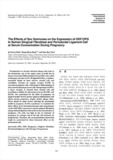

-
 * 본 문서는 배포용으로 복사 및 편집이 불가합니다.
* 본 문서는 배포용으로 복사 및 편집이 불가합니다.
미리보기
서지정보
· 발행기관 : 대한구강생물학회
· 수록지 정보 : International Journal of Oral Biology / 30권 / 3호
· 저자명 : Dong-Heon Baek, Ji-Yearn Shin, Soo-Boo Han
영어초록
Periodontitis is a chronic infectious disease that leads to the destruction, one of the major cause of tooth loss in human. Osteoclast Differentiation Factor(ODF), also called as Receptor activator of NF-xB ligand(RANKL), a surface-associated ligand on bone marrow stromal cells and osteoblasts, activates its cognate receptor RANK on osteoclast progenitor cells, which leads to differentiation of these mononucleated precursor cells. Osteoprotegerin(OPG), a decoy receptor, is released from stromal cells and osteoblasts to inhibit the interaction between RANKL and RANK. The experiment for the effect of pregnancy on gingival health showed greater gingival inflammation and edema during pregnancy, despite similar plaque index. There should be many factors affecting the periodontal health in pregnancy. In this experiment, we examined the direct effects of sex hormones(estrogen and progesterone) on the ODF/OPG expression in human gingival fibroblasts and periodontal ligament cells at the serum concentration of pregnancy. The ratio was high in the 1st trimester of pregnancy by estrogen and in the late 2nd trimester by progesterone. Therefore, the local periodontal destruction might be accelerated by these hormonal effect on the periodontal cells.참고자료
· 없음태그
-
자료후기
-
자주묻는질문의 답변을 확인해 주세요

꼭 알아주세요
-
본 학술논문은 (주)코리아스칼라와 각 학회간에 저작권계약이 체결된 것으로 AgentSoft가 제공 하고 있습니다.
본 저작물을 불법적으로 이용시는 법적인 제재가 가해질 수 있습니다. -
해피캠퍼스는 구매자와 판매자 모두가 만족하는 서비스가 되도록 노력하고 있으며, 아래의 4가지 자료환불 조건을 꼭 확인해주시기 바랍니다.
파일오류 중복자료 저작권 없음 설명과 실제 내용 불일치 파일의 다운로드가 제대로 되지 않거나 파일형식에 맞는 프로그램으로 정상 작동하지 않는 경우 다른 자료와 70% 이상 내용이 일치하는 경우 (중복임을 확인할 수 있는 근거 필요함) 인터넷의 다른 사이트, 연구기관, 학교, 서적 등의 자료를 도용한 경우 자료의 설명과 실제 자료의 내용이 일치하지 않는 경우
“International Journal of Oral Biology”의 다른 논문도 확인해 보세요!
-
정가4,000원
-
지식판매자
-
페이지6 페이지
어도비 PDF
-
최초등록일2016.04.01
-
최종저작일2005.09
-
문서 초안을 생성해주는 EasyAI


